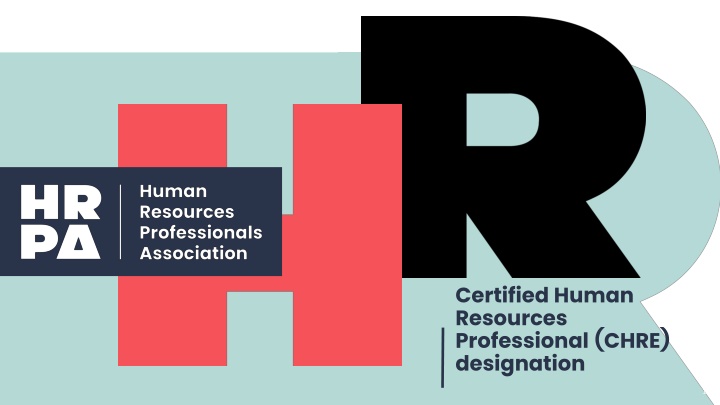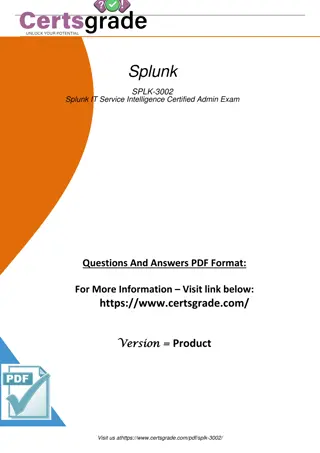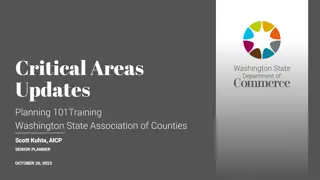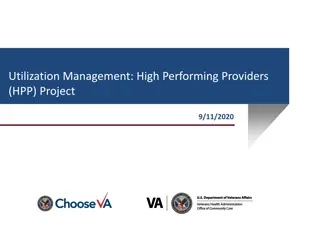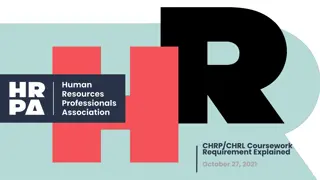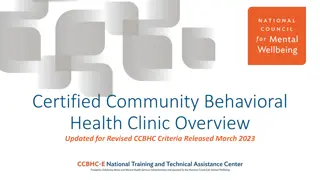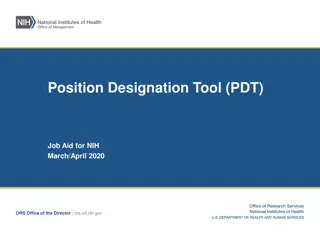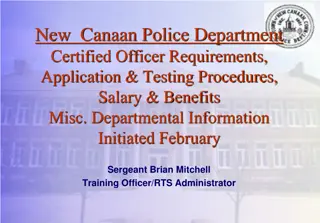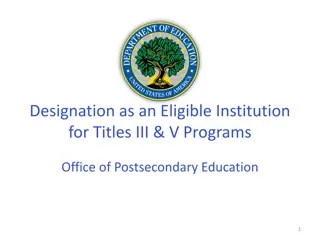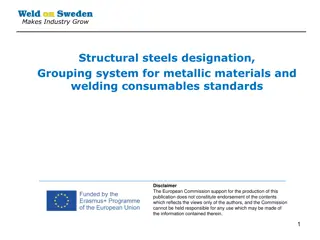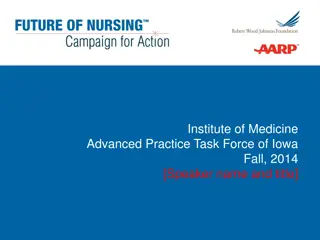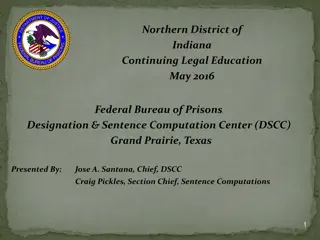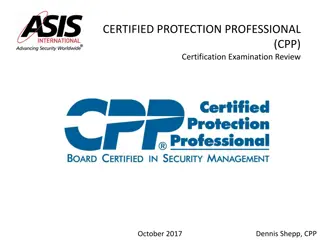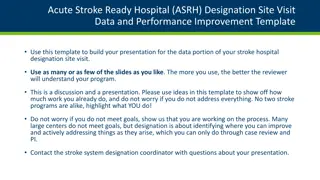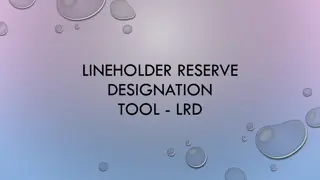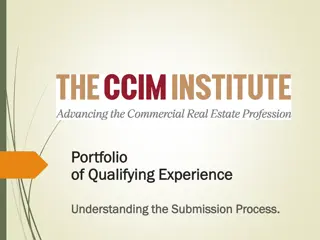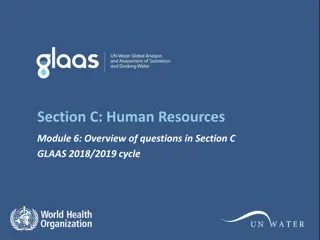Certified Human Resources Professional (CHRE) Designation Overview
In this overview, learn about the Certified Human Resources Professional (CHRE) designation, agenda topics covering CHRE evaluation, professional ethics, knowledge standards, and the role of the association in promoting public interest and professional standards.
Download Presentation

Please find below an Image/Link to download the presentation.
The content on the website is provided AS IS for your information and personal use only. It may not be sold, licensed, or shared on other websites without obtaining consent from the author.If you encounter any issues during the download, it is possible that the publisher has removed the file from their server.
You are allowed to download the files provided on this website for personal or commercial use, subject to the condition that they are used lawfully. All files are the property of their respective owners.
The content on the website is provided AS IS for your information and personal use only. It may not be sold, licensed, or shared on other websites without obtaining consent from the author.
E N D
Presentation Transcript
Certified Human Resources Professional (CHRE) designation 1
House-Keeping Items Webinar is NOT eligible for CPD hours. Webinar will be recorded and posted online. Our previously aired regulatory and how-to webinar series can be found on the Regulatory Webinars page of our website. Post answers to questions that we could not answer in the webinar. 2
Questions Not the appropriate place and time to address specific individual circumstances Sometimes the correct answer depends on some details that are not provided with the question Please contact the Office of the Registrar registrar@hrpa.ca with questions involving specific individual circumstances 3
Agenda HRPA s Objects The Three Designations Profile of a CHRE The Application Process The CHRE Evaluation Grid STAR Method Input from the CHRE Review Committee Chair new! Useful Tips Outcome of evaluation Q & A 4
Objects As per the Registered Human Resources Professionals Act, 2013 The objects of the Association are, (a) to promote and protect the public interest by governing and regulating the practice of members of the Association and firms in accordance with this Act and the by-laws, including, (i) establishing, maintaining, developing and enforcing standards of qualification, (ii) establishing, maintaining, developing and enforcing standards of practice, (iii) establishing, maintaining, developing and enforcing standards of professional ethics, (iv) establishing, maintaining, developing and enforcing standards of knowledge, skill and proficiency, and (v) regulating the practice, competence and professional conduct of members of the Association and firms; (b) to promote and increase the knowledge, skill and proficiency of members of the Association, firms and students; (c) to promote and protect the welfare and interests of the Association and of the human resources profession; (d) to promote inter-professional collaboration with other professional bodies; (e) to address any other matter that relates to the regulation of its members that the Board considers appropriate. 5
Entry level. Role is mostly administrative Professional Level HR Practitioners Independence of Action, Managing programs, projects and initiatives Senior High-impact leaders Organizational/Global rather than HR-centric perspective Directing/leading strategic initiatives that tie into overall company strategy/results Strategic rather than operational approach 6
Achievement Model Unlike the CHRP or CHRL, the CHRE is awarded based solely on the applicant s experiential achievements as an HR practitioner. The Certified Human Resources Executive (CHRE) designation is granted by assessing what the individual has already done. 7
Profile of a CHRE The CHRE is a professional HR designation reserved for senior HR leaders who have demonstrated high-impact leadership within their organizations and the HR profession. The CHRE is meant to recognize individuals who, through achievements, have reached the upper echelons of the HR profession. 8
Profile of a CHRE (cont.) Every senior executive has HR components to their position; however, the CHRE designation is not intended for general senior executives but rather senior HR executives. Every CEO is ultimately responsible for the HR of the organization, that doesn t mean the CEO is an HR Professional at the CHRE level. 9
Bio of a CHRE Have a deep and insightful understanding of human resources, business and organizations. Widely sought out for their advice and opinion, and are insightful & astute. True business partners, able to align the HR Function to the business strategy. 10
Recognized as leaders throughout their organization and beyond. Able to mobilize others in the pursuit of organizational objectives; their influence extends beyond the HR Function. Forward looking, well-informed about human resources but not HR centric. Broad knowledge of the full range of business issues ( ahead of the curve ) and ability to integrate HR into those issues. 11
Often work in the corporate world but can also be found in consulting. Common titles Chief Human Resources Officer Senior Vice-President, Human Resources Vice President, Human Resources Director, Human Resources 12
CHRE Application Process Minimum 10 years of experience as an HR practitioner. A significant portion of the experience must be at the senior, high-impact level. This will enable the applicant to draw on a broad range of experiences for the application. Registrant (member) of HRPA and remit application fee. 13
CHRE Application Process- cont. CHRE Application requires you to provide one example for each of the 15 competencies in the CHRE Evaluation Grid. Recommended that examples not be repeated more than once if you repeat an example, ensure that you tailor the example so that it addresses the competency for which it is being used Three parts to the application competency examples, resume and organizational charts. 14
Resume Organizational Charts Application must include a chronological resume Required for each organization that is used in a competency example in the application Resume should provide a high- level overview of your responsibilities and accomplishments in each senior- level position Organizational charts must indicate: the size of the organization who you report to, positions reporting to you and your direct reports 15
CHRE Evaluation Grid - Rubric CHRE Rubric is designed on a Scale of 1-5 Level 1-2 is below the level expected of a CHRE Level 3 5 is at or above the level expected of a CHRE A minimum overall score of 3 out of 5 with no scores of 1 is required to be granted the CHRE designation Rubric lists the 15 competencies that are considered fundamental to a Human Resources Executive 16
CHRE Competencies Individual skills 1. Critical thinking and analysis 2. Technological savvy 3. Research skills 4. Quantitative skills 5. Critical Legal Thinking Team skills 6. Emotional intelligence 7. Project management 8. Decision-making skills 9. Business acumen 10. Independence Organizational skills 11. Ethical behaviour and professionalism 12. Relationship management 13. Negotiation and influencing 14. Strategic and organizational leadership 15. Integration 17
CHRE Grid Negotiation and Influencing Well below the level expected of a CHRE Somewhat below the level expected of a CHRE At the level expected of a CHRE Somewhat above the level expected of a CHRE Well above the level expected of a CHRE Enabling competency Definition 1 2 3 4 5 Negotiation and influencing Negotiating solutions that balance the interests of all parties. Negotiates with clients and service providers. Carries out negotiations on behalf of the organization. Negotiates service (vendor) and/or collective agreements. Leads high-stakes critical negotiations that have a direct impact on the financial implications to the company. Demonstrates very strong negotiation and mediation skills. Finds common ground to facilitate agreement among opposing people and groups. Delivering persuasive communications that build agreement on a particular course of action. Does not have final decision-making authority. Positively influences colleagues to take decisions and actions that ultimately benefit the organization. Consults to handle high- stakes negotiations. Is a key member of a merger and acquisitions negotiating team. Called upon to mediate across the organization. 18
STAR Method Structure examples using the S.T.A.R. method. Situation Tasks Actions Results 19
Situation Describe the situation, problem or challenge. Choose an example that: demonstrates the significance of your experience the most difficult, complex, largest and successful problem, situation or task that you resolved. 20
Tasks Describe what you were tasked with, your responsibilities and assignments for the situation. 21
Action Describe the actions you took to resolve the problem, situation or task. Describe all of the actions detail each stage in the correct, logical order showing your thought processes, how you reached your conclusions and the steps you completed. 22
Results Describe the results. Give evidence to prove success and systemic organizational change. Show how the results benefited the business overall strategy rather than an HR- centric result. It can include metrics. If it is a group project or task, describe your role and how that role contributed to the results rather than the achievements of the team. 23
Evaluation Process The completed application is reviewed by a panel of the CHRE Review Committee. The panel assesses the competency examples against the CHRE Evaluation Grid. 24
CHRE Review Chair Intended to provide guidance. Additional Guidance is also available online and in the Guide to the CHRE Designation Disclaimer - Nothing that is being said is a guarantee for passing the application process. 25
Useful Tips Familiarize yourself with the 15 competencies and the CHRE Evaluation Grid; While examples must be HR-focused, explain how they impact the organizational strategy; The CHRE Review Committee is trained to assess each application by referencing the grid against the applicant s examples; Keep on point with the grid when writing your examples; Vary your examples, don t use the same example for more than two competencies. . Don t rely on supporting documentation it s the competency examples that are scored; 27
Evaluation Timeline CHRE application deadline is the last business day of each month. HRPA strives to release results within 8 weeks of the application deadline. Results are released via email. 28
Outcome Successful Unsuccessful Receive a letter confirming that they have met the criteria for the CHRE. Provided with the decision of the CHRE Review Committee. Decision includes: an overview of their score in each of the 15 competencies, and the reasons for the decision Authorized to include the CHRE abbreviation after name (Joe Smith, CHRE). A CHRE wall certificate will be sent printed quarterly. 29
Unsuccessful application - options Resubmission Applications can be resubmitted at any time. The application can be revised and the new information can be submitted as part of a resubmission. Use your previous results when deciding how to improve your resubmission. Your application will be sent to a new panel. 30
Appeal Disagreeing with a Panel s decision does not constitute grounds for an appeal. Grounds for appeal: Denial of Natural Justice or An error in the decision itself, e.g., the committee or Registrar In order to appeal the decision, a formal Request for Appeal form must be filed within 30 days of receiving the decision. No new information may be submitted as part of an appeal. 31
Continuing Professional Development (CPD) Requirement Registrants who hold the CHRE designation must complete 66.67 hours of continuing professional development every three years. If you have more than one designations, your CPD period is aligned with your current CHRP or CHRL CPD date. Unsure of the CPD submission deadline? registrar@hrpa.ca 32
Questions Webinar not eligible for CPD hours. Not the appropriate place to address specific individual circumstances. Sometimes the correct answer depends on some details that are not provided with the question. registrar@hrpa.ca 33
Margaret Wilson, CHRL mwilson@hpra.ca 416-923-2324 x343 Regulatory Process Specialist Human Resources Professionals Association 34
